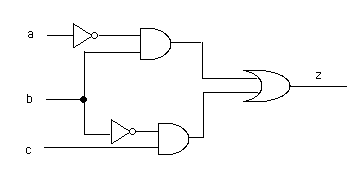CSCI 110, Spring 2011
Home | | Course Schedule | | Assignments | | Lecture NotesCSCI 110 Lab 8
Binary ArithmeticDue today at the end of class class.
Problem 1. Binary Arithmetic
a) Convert the decimal numbers 53 and 27 to eight bit binary form and to Hexadecimal.
| Decimal | Binary | Hexadecimal |
| 53 | ||
| 27 |
b) Using binary arithmetic, find the sum of the following binary numbers:
-
00111011
00011101
Demonstrate how you arrived at your answer by showing the carries at each place.
c) Find the decimal forms of each of the above binary numbers and the sum you computed in part b. (You should be able to use these to check your answer to part b)
d) Write the numbers 89 and -37 in binary two's complement representation. Show how you would add the two resulting binary numbers to find the binary result of subtracting 89 - 37.
Compute the decimal form of your result to check your answer.
| Decimal | Two's Complement |
| 89 | |
| -37 |
Compute 89 - 37 in binary below. Check your answer by converting it to decimal:
e) What is the largest positive integer you can represent with 8 bit two's complement representation? What would be the largest if you only had 4 bit two's complement representation? In general, if you have n bits--what is the largest positive integer you can represent in two's complement representation? (Remember that the first bit is used to indicate the sign of the number).
Problem 2. Digital Circuits
Write a logical expression that corresponds to the output of the following circuit. Draw and fill
in a truth table that shows what the output would be for each possible combination of inputs.

What To Turn In.
- Written solutions to problems 1 and 2 above